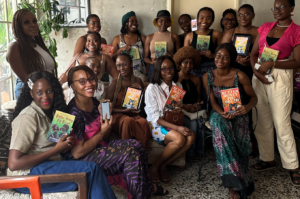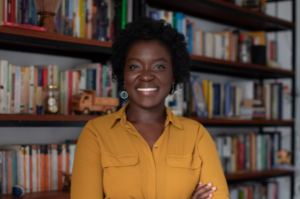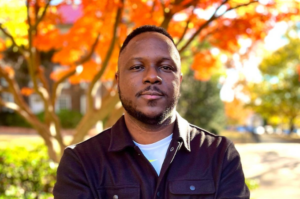
The Teller of Secrets by Bisi Adjapon was recently published in Nigeria. We are truly excited for her Nigerian readers who are about to be wowed by the gripping story of Esi Agyekum, a Nigerian-American girl living in 1960s Ghana and exploring her sexuality under the shadows of patriarchal standards. In this interview, Adjapon takes us behind the scenes of the story, sharing some intriguing details about the character and her own experience as a writer.
***
Congratulations on the publication of your novel The Teller of Secrets. Was the journey to publication all that you hoped it would be?
It wasn’t, it was better! You know, the normal path to publication requires submission and then the torturous wait for an answer. The Teller of Secrets was first published in Nigeria as Of Women and Frogs. I had already moved on and was on my second novel when HarperCollins acquired World English rights. There was no question about my not having an African publisher. Being more familiar with the publishing scene, I knew which publisher I wanted. Happily, Ouida Books was enthusiastic. It’s been a rewarding, exhilarating experience.
It’s a very West African novel, set in Ghana, Nigeria and Senegal. What informed your choice of countries along the West African coast, and why these ones in particular?
I set the novel in those countries because I wrote primarily for an African audience. West Africa seemed like a good place to start. I’m very particular about realistic depiction of culture and setting. Since I was in America and couldn’t afford travel, it was easier to start with societies I was already familiar with. Like Esi, I’m half Nigerian and half Ghanaian. I chose to place feisty aunties in Nigeria and more traditional women in Ghana. Which is not to say Ghanaian women are more subservient as opposed to Nigerian women. There are strong women in every society. It just seemed like a fun contrast. When I studied in Senegal, I was shocked to discover that, at the time, women couldn’t buy contraception without permission from their husbands. Therefore it was symbolic for Esi to fully come of age there.
Esi’s story will resonate with women everywhere. What’s the most important thing that you’d like readers to remember about her?
She is funny, strong and intelligent and though she sometimes makes wrong choices, she is a fierce survivor.
You adopt the first-person narrative voice in telling this coming-of-age story. Why?
I tried different points of view: Omniscient, third person, etc., but I found myself restless. I wasn’t enjoying my writing. It wasn’t until I opted for the first person, present-tense streams of consciousness that it clicked. It was fun for me to get into her head and watch her grow. I’ve worked with children all my life. For me, they are the most interesting. Their thoughts are unfiltered and they act with instinct until society constrains them. I enjoyed watching Esi grow from a naïve, impulsive child into a fully grown woman.
The Teller of Secrets explores several subjects that might come across as taboo to some. Were you worried about the sort of reception the story would get?
Initially I was a bit worried, but I had to lift the veil off taboo subjects like sex. Many girls are growing up in ignorance. That exposes them to exploitation and unwanted pregnancies. It is troubling that even now, there are men who deny their women contraception and subject them to atrocities. I use graphic descriptions to force us to see ourselves as we are. Hopefully we are shocked enough to demand changes.
The rich character development in this novel is one of the things that readers will enjoy. Which character was the most challenging to write?
Rudolph. I didn’t want to portray him as a purely negative character. He is controlling because he is insecure and, in flexing his societal notion of manhood, doesn’t realise how damaging it is, how he stood to lose the woman he loved. At the same time, he could be vulnerable, caring and tender. To some extent, he too is a victim of patriarchy. I hope I succeeded in showing his complexity.
The relationship between Esi, Auntie and her step-siblings is a tumultuous one, especially in her early years. What is the reader to make of Esi’s father’s role in all of this?
Esi’s father is the captain of the home. He’s the one with the money and power, the one who adores her, who charts a non-traditional path for her, setting her up for rivalry with her siblings. Esi has to figure out for herself that, whatever their shortcomings, her sisters and Auntie are also victims of patriarchy, just as she is. She has more in common with them than she realizes.
Are there any writing rituals you have found to be helpful over the years?
I’m still figuring it out, to be honest. When it comes to novels though, I usually dream of the concept. I figure out what story I want to tell, how I want the book to end, and come up with a title even before I begin the first draft. The title informs the story arc and then I can start with confidence, though the middle may go through several changes.
If you could give a piece of advice to the younger Bisi Adjapon, what would it be?
Don’t put off your dreams. Write and write and write. Don’t let opportunities slip by, thinking you’re not ready. When the door opens, step into it with courage. Don’t fear that you have nothing worthy to say.
Many writers agonise over the second novel. Should the readers be expecting something from you soon?
Fortunately, I wrote my “second” novel before The Teller of Secrets, so I just polished and sent it off. It’s already in the production stage and will be out in November 2022.









COMMENTS -
Reader Interactions